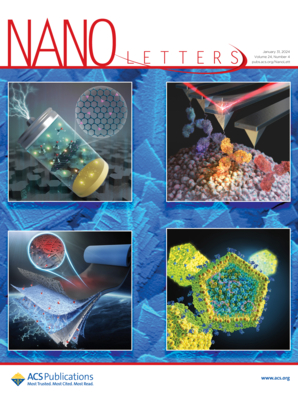混合-双门控MoS2晶体管的现场可编程双峰开关。
IF 9.1
1区 材料科学
Q1 CHEMISTRY, MULTIDISCIPLINARY
引用次数: 0
摘要
范德华固体的超高表面体积比和可扩展的层间间距允许它们的通道体与外来分子强烈和动态地相互作用。然而,在一个单一的集成平台中控制如此多的分子相互作用仍然是一个技术挑战。在这里,我们介绍了一种所谓的混合双门控电压控制双峰开关,通过将高k固体和离子液体电解质作为双栅极电介质进行共积,在单个MoS2晶体管上演示。在应用同步双栅电压时,它会产生两种独特但可互换的开关模式:静电近玻尔兹曼极限开关和插层驱动的金属绝缘体转换。除了在低栅极电压(VG)条件下提高场效应开关性能(Ion/Ioff ~ 109, SSmin ~ 61 mV/dec)外,在高栅极电压条件下还可以实现伴随2h到1t结构变化的陡坡金属-绝缘体转变。通过结合共形电极钝化和独立的双门控调制,所提出的器件平台通过广泛的主客相互作用实现高度稳定的、场可调谐的双峰开关行为。本文章由计算机程序翻译,如有差异,请以英文原文为准。
Field-Programmable Bimodal Switching in a Hybrid-Dual-Gated MoS2 Transistor.
The ultrahigh surface-to-volume ratio and expandable interlayer spacing of van der Waals solids allow their channel bodies to strongly and dynamically interact with foreign molecules. However, controlling such multiple molecular interactions within a single, integrated platform has remained a technical challenge. Herein, we introduce a so-called hybrid-dual-gated voltage-controlled bimodal switch demonstrated on a single MoS2 transistor by cointegrating high-k solid and ionic liquid electrolytes as dual-gate dielectrics. Upon applying the synchronized dual-gate voltages, it results in two distinctive yet interchangeable switching modes: electrostatic near-Boltzmann-limit switching and intercalation-driven metal-insulator transitions. In addition to the improved field-effect switching performances (Ion/Ioff ∼ 109, SSmin ∼ 61 mV/dec) in the low-gate voltage (VG) regime, the steep-slope metal-insulator transitions accompanying 2H-to-1T structural alternations can also be achieved in the high-VG regime. By incorporating conformal electrode passivation and independent dual-gating modulation, the proposed device platform enables highly stable, field-tunable bimodal switching behaviors through broad-range host-guest interactions.
求助全文
通过发布文献求助,成功后即可免费获取论文全文。
去求助
来源期刊

Nano Letters
工程技术-材料科学:综合
CiteScore
16.80
自引率
2.80%
发文量
1182
审稿时长
1.4 months
期刊介绍:
Nano Letters serves as a dynamic platform for promptly disseminating original results in fundamental, applied, and emerging research across all facets of nanoscience and nanotechnology. A pivotal criterion for inclusion within Nano Letters is the convergence of at least two different areas or disciplines, ensuring a rich interdisciplinary scope. The journal is dedicated to fostering exploration in diverse areas, including:
- Experimental and theoretical findings on physical, chemical, and biological phenomena at the nanoscale
- Synthesis, characterization, and processing of organic, inorganic, polymer, and hybrid nanomaterials through physical, chemical, and biological methodologies
- Modeling and simulation of synthetic, assembly, and interaction processes
- Realization of integrated nanostructures and nano-engineered devices exhibiting advanced performance
- Applications of nanoscale materials in living and environmental systems
Nano Letters is committed to advancing and showcasing groundbreaking research that intersects various domains, fostering innovation and collaboration in the ever-evolving field of nanoscience and nanotechnology.
 求助内容:
求助内容: 应助结果提醒方式:
应助结果提醒方式:


